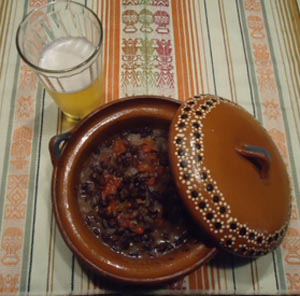Mexican Kitchen

The phrase “Mexican beer” can bring to mind sipping an ice cold Corona on the beach, enjoying a michelada cocktail on a leafy plaza, or sharing the seasonal Noche Buena brew with friends during the winter holidays. In any case, the quality of Mexican beer is recognized and appreciated throughout the world.
Fermented beverages have been made in Mexico since pre-Hispanic times, and the ancient drink, pulque — made from the sap of the maguey plant — continues to be produced and consumed today.
Barley and wheat based beers were introduced by the Spaniards in the mid-16th century, but high taxation made them inaccessible to most of the populace. It was not until the late 19th century that German immigrants to Mexico created a vast improvement in the beer produced in the country. By the early 20th century, beer had become an important industry in Mexico, helped along by Prohibition in the United States, which gave rise to a brisk cross-border business in alcoholic beverages.
For years, the two brewing giants, Grupo Modelo and Cuahutemoc Moctezuma — both recently acquired by foreign companies — dominated the Mexican beer industry. But recently that has changed, with the huge companies agreeing to open up the local beer market, giving microbreweries a chance to get their products onto restaurant menus and store shelves.
Small craft breweries are springing up throughout the country, with names like Atomica and Border Psycho joining two of the older craft breweries, Primus and Minerva. At a gourmet trade show held in Mexico City this past summer, 56 craft beer makers were on hand to present their products.
Although the number of Mexican microbreweries is small compared to the 2,500 or so in the US, Mexicans are among the world’s top beer drinkers, ranking number six in beer consumption and downing an impressive 16.3 gallons per capita yearly.
And Mexico’s beers can also be used in cooking, lending a depth of flavor to some of autumn’s heartiest dishes, including stews and beans. They are particularly well suited to Northern Mexican cooking, with its emphasis on beef dishes; however, beer makes a wonderful marinade for chicken that’s headed for the grill.
The sudsy brew also appears frequently in queso fundido, Mexico’s version of cheese fondue. A tasty version comes from Toluca, famous for its chorizo, but a vegetarian version can be made without chorizo.
Dark beers are best in meat stews, and either light or dark is fine in bean dishes and queso fundido. Light beer works better as a substitute in dishes calling for pulque, when pulque is not available. As for the michelada, the best beer for this is whichever one you prefer.
- Drunken Mexican beans: Frijoles borrachos
- Mexican beef stew with beer: Guisado de res con cerveza
- Mexican grilled chicken with chipotle beer marinade: Pollo a la parilla con chipotle y cerveza
- Mexican beer cocktail: Michelada

